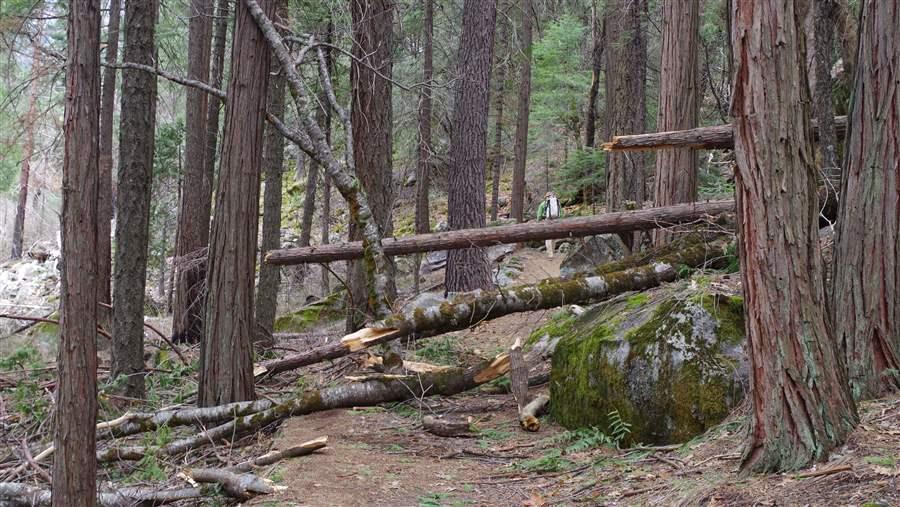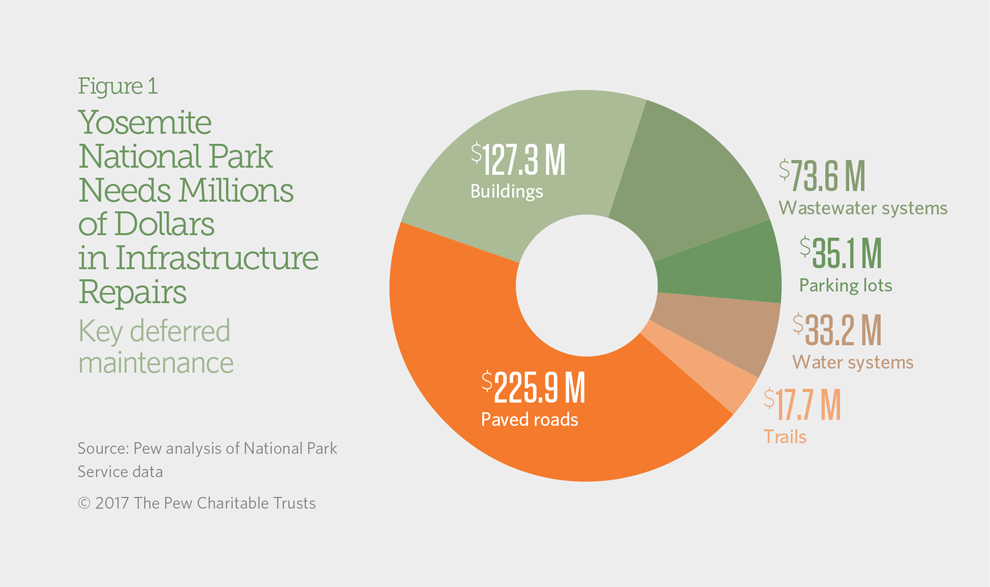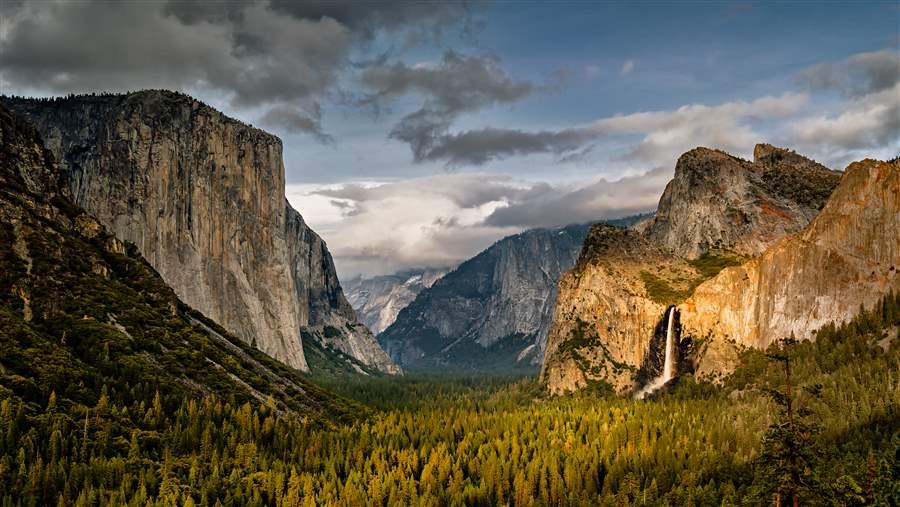Yosemite National Park
California
Pew created this case study using National Park Service deferred maintenance data issued in fiscal year 2015. The information listed here may no longer reflect the NPS site’s current condition or maintenance requirements. To find the most up-to-date information, please use the National Park Repair Needs tool.
This case study was updated on July 31, 2017, to reflect newly released 2016 data and to correct references to calendar and fiscal year.
This page was updated in December 2016 to streamline the information and to correct source information.
Visitors to Yosemite National Park are treated to a distinctive landscape of soaring cliffs, domes, and free-flowing waterfalls. Together with the scenic backdrop for mountain meadows and giant sequoia groves, these dramatic features make the park one of the nation’s most exceptional natural and historic places. Today, however, Yosemite has a backlog of hundreds of millions of dollars in infrastructure repairs, and those maintenance needs are negatively affecting the experience of park visitors and the local ecosystem.1
Yosemite was established in 1890, predating the National Park Service (NPS) by nearly 30 years. John Muir, the famous naturalist, used the wonders of this place to convince lawmakers to create the NPS in 1916 as an official federal agency with a mandate to conserve the nation’s natural and historic gems for future generations to enjoy.2 But Muir’s vision is in jeopardy, as the NPS confronts the challenge of inadequate funding for infrastructure repairs not only for Yosemite, but also for park sites across the country.

Fallen trees lie across a trail in Yosemite National Park, part of a half-billion-dollar deferred maintenance problem there.
© Danna Moore Pfahl
Maintenance challenges
Park rangers struggle to keep Yosemite’s many attractions open. The park spans 1,200 square miles,3 and traffic and congestion are common, especially during busy summer months. More than 95 percent of park visitors pass through Yosemite Valley, so the Valley Loop Road experiences the heaviest traffic.4 Developed as a stagecoach route in 1872, that road alone needs $19 million in deferred maintenance. Add to that the repair needs of the Tioga, Wawona, Glacier Point, and Hetch Hetchy roads, among others, and the total cost of fixing the park’s roads comes to $225 million.
Yosemite, where my deep love of the outdoors was born a few short decades ago, needs more than half a billion dollars in repairs, including $100 million of which is considered critical for visitor safety and access.” Gavin Newsom, lieutenant governor of California
Once visitors get out of their cars, they find walking, hiking, and biking trails that are in disrepair or closed. More than $17 million in deferred maintenance affects these systems, including the Yosemite Bike Path, the Stubblefield Canyon Trail, and the Clark Point Spur Trail, which leads visitors to the famed Vernal Fall.
Even more urgent, Yosemite’s Mariposa Grove of giant sequoias is now virtually inaccessible.5 President Abraham Lincoln first protected the grove in 1864 for “public use, resort, and recreation,” and that presidential act has long been considered the seed of America’s renowned system of national and state parks.6 Deferred maintenance of the park’s sewage and water lines has caused chlorinated water to leak into the grove, affecting the growth and longevity of some of its more than 500 mature sequoias, which are among the oldest living things on Earth.7 The agency estimates that it will need $1.8 million to repair the leaks.8
The historic properties within the park have problems, too. For instance, the Ansel Adams Gallery, established by the noted photographer and his wife as an artists’ workshop and display site for many of his special edition prints, is in disrepair. Together, the large and growing number of damaged park structures faces more than $127 million in deferred maintenance.
Recommendations
To address the deferred maintenance at Yosemite and other NPS sites in California and across the country, Congress should:
- Ensure that infrastructure initiatives include provisions to address park maintenance.
- Provide dedicated annual federal funding for national park repairs.
- Enact innovative policy reforms to ensure that deferred maintenance does not escalate.
- Provide more highway funding for NPS maintenance needs.
- Create more opportunities for public-private collaboration and donations to help restore park infrastructure.
Yosemite National Park Facts
2016
|
Visitor spending |
$520.6 million |
|
Jobs created by visitor spending |
7,900 |
|
Economic output |
$686.3 million |
|
Labor income |
$239 million |
|
Visits |
5,028,868 |
|
Deferred maintenance (fiscal year 2015) |
$560.7 million |
Sources: National Park Service, “Annual Visitation Reports by Years: 2006 to 2016,” accessed Feb. 17, 2017, https://irma.nps.gov/Stats/SSRSReports/National Reports/Annual Visitation By Park (1979 - Last Calendar Year); National Park Service, “Visitor Spending Effects,” accessed Aug. 22, 2016, https://www.nps.gov/subjects/socialscience/vse.htm; National Park Service, “NPS Deferred Maintenance Reports,” accessed Aug. 19, 2016, https://www.nps.gov/subjects/plandesignconstruct/defermain.htm; Pew converted NPS data from this webpage and other NPS sources into a searchable database.
© 2017 The Pew Charitable Trusts

The Pew Charitable Trusts works alongside the National Park Conservation Association, the National Trust for Historic Preservation, and other national and local groups to ensure that our national park resources are maintained and protected for future generations to enjoy.
Endnotes
- National Park Service, “NPS Deferred Maintenance Reports,” accessed Aug. 19, 2016, https://www.nps.gov/subjects/plandesignconstruct/defermain.htm. Pew converted Park Service data from this webpage and other NPS sources into a searchable database.
- National Park Service, “John Muir,” accessed Aug. 19, 2016, https://www.nps.gov/yose/learn/historyculture/muir.htm; National Park Service, “History,” accessed Aug. 24, 2016, https://www.nps.gov/aboutus/history.htm.
- National Park Service, “Park Statistics,” accessed Aug. 19, 2016, https://www.nps.gov/yose/learn/management/statistics.htm.
- U.S. News and World Report, “Yosemite Neighborhoods and Towns,” accessed Aug. 19, 2016, http://travel.usnews.com/Yosemite_CA/ Neighborhoods/.
- National Park Service, “Restoration of the Mariposa Grove of Giant Sequoias Project,” accessed Sept. 1, 2016, https://www.nps.gov/yose/planyourvisit/mariposagrove.htm. Access is limited to a 12-mile round-trip trail, traversed via horse or on foot, that leads to a location in the grove where only a small number of sequoias are visible.
- National Park Service, “Mariposa Grove of Giant Sequoias,” accessed Aug. 31, 2016, https://www.nps.gov/yose/planyourvisit/upload/mgrove.pdf; History.com, “This Day in History,” accessed Aug. 31, 2016, http://www.history.com/this-day-in-history/yosemite-nationalpark-established.
- National Parks Traveler, “Plans to Restore Mariposa Grove of Giant Sequoias in Yosemite National Park Open for Comments,” accessed Aug. 31, 2016, http://www.nationalparkstraveler.com/2013/03/plans-restore-mariposa-grove-giant-sequoias-yosemite-national-parkopen-comments22880.
- National Park Service, “National Park Service Fiscal Year 2016 Budget Justifications,” accessed Aug. 31, 2016, https://www.nps.gov/aboutus/upload/FY-2016-Greenbook.pdf.














